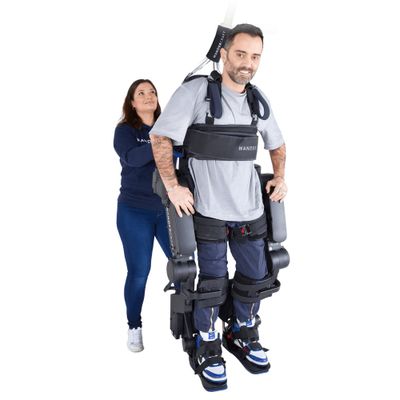

- Home
- Companies
- Wandercraft
- Products
- Atalante - Model X - Self-Balancing for ...

Atalante - Model X - Self-Balancing for Hands Free Movement
We designed the first exoskeleton that gives the opportunity to each person who wishes to do so*, to stand up and walk again. Atalante X emulates human walk, and ensures your safety and autonomy through dynamic walking algorithms. For a new kind of rehabilitation.
With the innovative self-balancing feature, Atalante allows for multi-tasking and cognitive involvement as part of treatments. It is designed to help carry out lower limb, trunk and upper limbs reinforcement exercises in a safe upright position.
With the innovative self-balancing feature, Atalante allows for multi-tasking and cognitive involvement as part of treatments. It is designed to help carry out lower limb, trunk and upper limbs reinforcement exercises in a safe upright position.
Dynamic standing for early care
EarlyGait promotes early management of patients with severe gait disorders and supports them in their first steps with a self-stabilising gait pattern. By starting with a small step gait, your patients feel confident in the first few uses of Atalante X and can progress to a more natural gait pattern.
Our Indications
The Atalante X exoskeleton is intended to be used on adult individuals with the following deficiencies:
- Motor complete paraplegia,
- Motor incomplete paraplegia,
- Hemiplegia due to cerebrovascular accident or to any other cause of acquired brain injury.
After a Neurological lesion, it is recommended to start an early, intense and specific rehabilitation in order to maximize functional recovery and prevent the appearance of complications secondary to the loss of mobility caused by the impairment.
The scientific community has identified the integration of robotic rehabilitation tools, including gait training exoskeletons, as a strategy that enables early care, intense, and specific rehabilitation in these patients (Calabro, 20211).
- Definition in the context of rehabilitation : as soon as possible after the Neurological lesion, once the initial medical stabilization is achieved.
- Early mobilization and verticalization might improve functional recovery, especially with increasing the frequency of sessions (Bernhardt, 20161), and decrease risk of complications from prolonged immobilization.
- The design of Atalante X, a self-balancing, hands-free device with autonomous standing, sitting and assisted ambulation, enables effortless verticalization of patients in the early phases of care.
- A study conducted by Wandercraft, in a population of hemiparetic patients in the acute phase of their stroke, suggests that the use of Atalante could improve the walking ability and balance of patients (reference Inspire2). Wandercraft will initiate its first randomized, international, multi-center comparative study in 2022 to confirm these results.
Number of repetitions per unit (e.g. number of steps per session). Intensity can also reflect the intensity of the patient`s effort.
In a population of post-stroke hemiparetic patients, performing intense gait training, by increasing the number of repetitions and effort provided by the patient, would enable improvements in lower limb motor function, walking speed, muscle tone, sitting and standing balance, depression, anxiety, quality of life, and independence in activities of daily living (Veerbeek & Kwakkel 20141).
Atalante enables hundreds, up to thousands of steps per session (on average 600 steps per session and up to 2300 steps ); and an active participation of the patient thanks to ActiveGait mode (on average 37% of the trainig time in Atalante is performed in active mode).
- Specific work corresponds to the fact of working on the task that one wishes to achieve. For example, to relearn to walk, one must walk.
- Task-specific training can have beneficial effects on sitting and standing balance in patients with paraplegia or paraparesis"" (Tsé 20181). Specific gait work enables improvements in walking speed and distance in hemiparetic patients (Peurala 2014).
- Atalante is hands-free and self-balancing, it enables to work on the balance of the trunk in an upright position with the help of straightening exercises such as squat or trunk maintenance thanks to side steps; to work specifically and actively on walking, and this, in an asymmetrical way.



